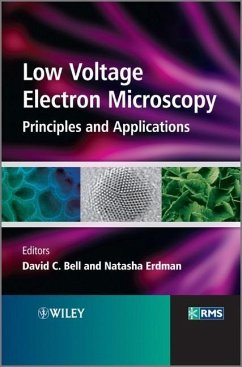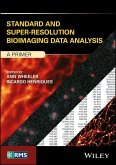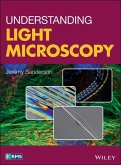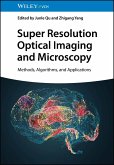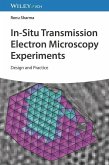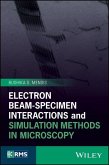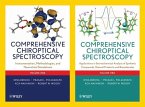David Bell, Natasha ErdmanPrinciples and Applications
Low Voltage Electron Microscopy
Principles and Applications
Herausgeber: Bell, David C; Erdman, Natasha
David Bell, Natasha ErdmanPrinciples and Applications
Low Voltage Electron Microscopy
Principles and Applications
Herausgeber: Bell, David C; Erdman, Natasha
- Gebundenes Buch
- Merkliste
- Auf die Merkliste
- Bewerten Bewerten
- Teilen
- Produkt teilen
- Produkterinnerung
- Produkterinnerung
Part of the Wiley-Royal Microscopical Society Series, this book discusses the rapidly developing cutting-edge field of low-voltage microscopy, a field that has only recently emerged due to the rapid developments in the electron optics design and image processing.
It serves as a guide for current and new microscopists and materials scientists who are active in the field of nanotechnology, and presents applications in nanotechnology and research of surface-related phenomena, allowing researches to observe materials as never before.
Andere Kunden interessierten sich auch für
![Standard and Super-Resolution Bioimaging Data Analysis Standard and Super-Resolution Bioimaging Data Analysis]() Standard and Super-Resolution Bioimaging Data Analysis88,99 €
Standard and Super-Resolution Bioimaging Data Analysis88,99 €![Understanding Light Microscopy Understanding Light Microscopy]() Jeremy SandersonUnderstanding Light Microscopy213,99 €
Jeremy SandersonUnderstanding Light Microscopy213,99 €![Super Resolution Optical Imaging and Microscopy Super Resolution Optical Imaging and Microscopy]() Super Resolution Optical Imaging and Microscopy102,99 €
Super Resolution Optical Imaging and Microscopy102,99 €![In-Situ Transmission Electron Microscopy Experiments In-Situ Transmission Electron Microscopy Experiments]() Renu SharmaIn-Situ Transmission Electron Microscopy Experiments89,99 €
Renu SharmaIn-Situ Transmission Electron Microscopy Experiments89,99 €![Electron Beam-Specimen Interactions and Simulation Methods in Microscopy Electron Beam-Specimen Interactions and Simulation Methods in Microscopy]() Budhika G. MendisElectron Beam-Specimen Interactions and Simulation Methods in Microscopy141,99 €
Budhika G. MendisElectron Beam-Specimen Interactions and Simulation Methods in Microscopy141,99 €![Characterization of Materials, 3 Volume Set Characterization of Materials, 3 Volume Set]() Elton N. KaufmannCharacterization of Materials, 3 Volume Set1.113,99 €
Elton N. KaufmannCharacterization of Materials, 3 Volume Set1.113,99 €![Comprehensive Chiroptical Spectroscopy, 2 Volume Set Comprehensive Chiroptical Spectroscopy, 2 Volume Set]() Nina BerovaComprehensive Chiroptical Spectroscopy, 2 Volume Set505,99 €
Nina BerovaComprehensive Chiroptical Spectroscopy, 2 Volume Set505,99 €-
-
-
Part of the Wiley-Royal Microscopical Society Series, this book discusses the rapidly developing cutting-edge field of low-voltage microscopy, a field that has only recently emerged due to the rapid developments in the electron optics design and image processing.
It serves as a guide for current and new microscopists and materials scientists who are active in the field of nanotechnology, and presents applications in nanotechnology and research of surface-related phenomena, allowing researches to observe materials as never before.
Hinweis: Dieser Artikel kann nur an eine deutsche Lieferadresse ausgeliefert werden.
It serves as a guide for current and new microscopists and materials scientists who are active in the field of nanotechnology, and presents applications in nanotechnology and research of surface-related phenomena, allowing researches to observe materials as never before.
Hinweis: Dieser Artikel kann nur an eine deutsche Lieferadresse ausgeliefert werden.
Produktdetails
- Produktdetails
- RMS - Royal Microscopical Society
- Verlag: Wiley & Sons / Wiley-Blackwell
- 1. Auflage
- Seitenzahl: 224
- Erscheinungstermin: Dezember 2012
- Englisch
- Abmessung: 236mm x 154mm x 20mm
- Gewicht: 519g
- ISBN-13: 9781119971115
- ISBN-10: 111997111X
- Artikelnr.: 35675931
- Herstellerkennzeichnung
- Libri GmbH
- Europaallee 1
- 36244 Bad Hersfeld
- gpsr@libri.de
- RMS - Royal Microscopical Society
- Verlag: Wiley & Sons / Wiley-Blackwell
- 1. Auflage
- Seitenzahl: 224
- Erscheinungstermin: Dezember 2012
- Englisch
- Abmessung: 236mm x 154mm x 20mm
- Gewicht: 519g
- ISBN-13: 9781119971115
- ISBN-10: 111997111X
- Artikelnr.: 35675931
- Herstellerkennzeichnung
- Libri GmbH
- Europaallee 1
- 36244 Bad Hersfeld
- gpsr@libri.de
David C. Bell received his PhD in physics from the University of Melbourne, Australia in 1997 and completed his postdoctoral studies at MIT in 1999. He was research faculty and principal investigator at the University of Minnesota from 2000 to 2002. In 2003, he joined the Center for Nanoscale Systems at Harvard University as a principal scientist and became the Manager for Imaging and Analysis in 2007. He has been a lecturer in applied physics at Harvard since 2003 and is a teaching professor at the Harvard Extension School. In 2007, he was a visiting scientist at the Department of Materials, Oxford University, UK. Dr Bell is one of the renowned experts in the field of elemental analysis using electron microscopy (TEM and STEM) and has co-authored a book on this subject. He has authored more than 70 research papers on the subjects of microscopy, materials science and biology and holds several patents. He is an elected Fellow of the Royal Microscopical Society, UK. Natasha Erdman received her Ph.D. in Materials Science and Engineering from Northwestern University (Chicago, IL) in 2002. After completing her Ph.D. she worked as a Senior Research Chemist at UOP LLC (currently Honeywell) in Des Plaines, IL focusing on investigation of structure-properties relationship in various catalysts using electron microscopy techniques. In 2004 Dr. Erdman as joined JEOL USA Inc., and currently serves as an SEM and Ion-Beam Product Manager. She has authored over 30 peer-reviewed papers on the subjects of microscopy, materials science, chemistry and biology and is a renowned expert on ion-beam based sample preparation techniques for electron microscopy.
List of Contributors ix
Preface xi
1 Introduction to the Theory and Advantages of Low Voltage Electron
Microscopy 1
David C. Bell and Natasha Erdman
1.1 Introduction 1
1.2 Historical Perspective 2
1.3 Beam Interaction with Specimen-Elastic and Inelastic Scattering 3
1.3.1 The Scattering Cross Section 6
1.3.2 Effects of Specimen Damage 10
1.4 Instrument Configuration 11
1.4.1 Scanning Electron Microscope 11
1.4.2 Transmission Electron Microscope 12
1.4.3 Scanning Transmission Electron Microscope 12
1.5 Influence of Electron Optics Aberrations at Low Voltages 12
1.5.1 Spherical Aberration 13
1.5.2 Effect of Chromatic Aberration 14
1.5.3 The Diffraction Limit 15
1.5.4 Optimizing Spot Size for SEM and STEM 15
1.6 SEM Imaging at Low Voltages 16
1.6.1 Primary Contrast Signals and their Detection in SEM 18
1.6.2 Backscattered Electrons 18
1.6.3 Secondary Electrons 21
1.6.4 Charge Balance in SEM 23
1.6.5 SEM Image Contrast 24
1.6.6 Microanalysis in SEM at Low Voltages 25
1.7 TEM/STEM Imaging and Analysis at Low Voltages 26
1.8 Conclusion 27
References 28
2 SEM Instrumentation Developments for Low kV Imaging and Microanalysis 31
Natasha Erdman and David C. Bell
2.1 Introduction 31
2.2 The Electron Source 33
2.3 SEM Column Design Considerations 36
2.4 Beam Deceleration 41
2.5 Novel Detector Options and Energy Filters 43
2.5.1 Secondary Detectors 43
2.5.2 Backscatter Detectors 45
2.6 Low Voltage STEM in SEM 48
2.7 Aberration Correction in SEM 50
2.8 Conclusions 53
References 53
3 Extreme High-Resolution (XHR) SEM Using a Beam Monochromator 57
Richard J. Young, Gerard N.A. van Veen, Alexander Henstra and Lubomir Tuma
3.1 Introduction 57
3.2 Limitations in Low Voltage SEM Performance 58
3.2.1 Aberration Correction 58
3.2.2 Electron Source Energy Spread 59
3.3 Beam Monochromator Design and Implementation 59
3.4 XHR Systems and Applications 63
3.4.1 Elstar XHR Electron Column 64
3.4.2 Beam Deceleration for Extending Low-Voltage Performance 65
3.4.3 Combination of a Monochromator with Non-Immersion Lens 67
3.4.4 XHR Applications 68
3.5 Conclusions 69
Acknowledgements 70
References 70
4 The Application of Low-Voltage SEM-From Nanotechnology to Biological
Research 73
Natasha Erdman and David C. Bell
4.1 Introduction 73
4.2 Specimen Preparation Considerations 74
4.3 Nanomaterials Applications 76
4.3.1 Nanoparticles, Nanotubes and Nanowires 76
4.3.2 Nanoporous Materials 81
4.3.3 Graphene 83
4.4 Beam Sensitive Materials 84
4.5 Semiconductor Materials 85
4.6 Biological Specimens 87
4.7 Low-Voltage Microanalysis 91
4.8 Conclusions 92
References 93
5 Low Voltage High-Resolution Transmission Electron Microscopy 97
David C. Bell
5.1 Introduction 97
5.2 So How Low is Low? 99
5.3 The Effect of Chromatic Aberration and Chromatic Aberration Correction
100
5.4 The Electron Monochromator 103
5.5 Theoretical Tradeoffs of Low kV Imaging 105
5.6 Our Experience at 40 keV LV-HREM 109
5.7 Examples of LV-HREM Imaging 110
5.8 Conclusions 114
References 116
6 Gentle STEM of Single Atoms: Low keV Imaging and Analysis at Ultimate
Detection Limits 119
Ondrej L. Krivanek, Wu Zhou, Matthew F. Chisholm, Juan Carlos Idrobo, Tracy
C. Lovejoy, Quentin M. Ramasse and Niklas Dellby
6.1 Introduction 119
6.2 Optimizing STEM Resolution and Probe Current at Low Primary Energies
121
6.3 STEM Image Formation 128
6.3.1 Basic Principles 128
6.3.2 ADF Imaging 132
6.4 Gentle STEM Applications 135
6.4.1 Single Atom Imaging 135
6.4.2 Single Atom Spectroscopy 146
6.4.3 Single Atom Fine Structure EELS 152
6.5 Discussion 154
6.6 Conclusion 156
Acknowledgements 157
References 157
7 Low Voltage Scanning Transmission Electron Microscopy of Oxide Interfaces
163
Robert Klie
7.1 Introduction 163
7.2 Methods and Instrumentation 166
7.3 Low Voltage Imaging and Spectroscopy 168
7.3.1 SrTiO3/BiFeO3 Interface 168
7.3.2 Si3N4/SiO2 Interfaces 170
7.3.3 Ultrathin SrTiO3 films on GaAs 175
7.4 Summary 180
Acknowledgements 180
References 180
8 What's Next? The Future Directions in Low Voltage Electron Microscopy 185
David C. Bell and Natasha Erdman
8.1 Introduction 185
8.2 Unique Low Voltage SEM and TEM Instruments 186
8.2.1 Miniature SEM Columns 186
8.2.2 Dedicated Low Voltage TEM 187
8.2.3 The Helium Ion Microscope as an Alternative to Low Voltage SEM
Imaging 189
8.3 Cameras, Detectors, and Other Accessories 192
8.3.1 The Direct Electron Detector 192
8.3.2 Silicon Drift Detectors for Low kV Nanoanalysis 195
8.4 Conclusions 198
References 199
Index 201
Preface xi
1 Introduction to the Theory and Advantages of Low Voltage Electron
Microscopy 1
David C. Bell and Natasha Erdman
1.1 Introduction 1
1.2 Historical Perspective 2
1.3 Beam Interaction with Specimen-Elastic and Inelastic Scattering 3
1.3.1 The Scattering Cross Section 6
1.3.2 Effects of Specimen Damage 10
1.4 Instrument Configuration 11
1.4.1 Scanning Electron Microscope 11
1.4.2 Transmission Electron Microscope 12
1.4.3 Scanning Transmission Electron Microscope 12
1.5 Influence of Electron Optics Aberrations at Low Voltages 12
1.5.1 Spherical Aberration 13
1.5.2 Effect of Chromatic Aberration 14
1.5.3 The Diffraction Limit 15
1.5.4 Optimizing Spot Size for SEM and STEM 15
1.6 SEM Imaging at Low Voltages 16
1.6.1 Primary Contrast Signals and their Detection in SEM 18
1.6.2 Backscattered Electrons 18
1.6.3 Secondary Electrons 21
1.6.4 Charge Balance in SEM 23
1.6.5 SEM Image Contrast 24
1.6.6 Microanalysis in SEM at Low Voltages 25
1.7 TEM/STEM Imaging and Analysis at Low Voltages 26
1.8 Conclusion 27
References 28
2 SEM Instrumentation Developments for Low kV Imaging and Microanalysis 31
Natasha Erdman and David C. Bell
2.1 Introduction 31
2.2 The Electron Source 33
2.3 SEM Column Design Considerations 36
2.4 Beam Deceleration 41
2.5 Novel Detector Options and Energy Filters 43
2.5.1 Secondary Detectors 43
2.5.2 Backscatter Detectors 45
2.6 Low Voltage STEM in SEM 48
2.7 Aberration Correction in SEM 50
2.8 Conclusions 53
References 53
3 Extreme High-Resolution (XHR) SEM Using a Beam Monochromator 57
Richard J. Young, Gerard N.A. van Veen, Alexander Henstra and Lubomir Tuma
3.1 Introduction 57
3.2 Limitations in Low Voltage SEM Performance 58
3.2.1 Aberration Correction 58
3.2.2 Electron Source Energy Spread 59
3.3 Beam Monochromator Design and Implementation 59
3.4 XHR Systems and Applications 63
3.4.1 Elstar XHR Electron Column 64
3.4.2 Beam Deceleration for Extending Low-Voltage Performance 65
3.4.3 Combination of a Monochromator with Non-Immersion Lens 67
3.4.4 XHR Applications 68
3.5 Conclusions 69
Acknowledgements 70
References 70
4 The Application of Low-Voltage SEM-From Nanotechnology to Biological
Research 73
Natasha Erdman and David C. Bell
4.1 Introduction 73
4.2 Specimen Preparation Considerations 74
4.3 Nanomaterials Applications 76
4.3.1 Nanoparticles, Nanotubes and Nanowires 76
4.3.2 Nanoporous Materials 81
4.3.3 Graphene 83
4.4 Beam Sensitive Materials 84
4.5 Semiconductor Materials 85
4.6 Biological Specimens 87
4.7 Low-Voltage Microanalysis 91
4.8 Conclusions 92
References 93
5 Low Voltage High-Resolution Transmission Electron Microscopy 97
David C. Bell
5.1 Introduction 97
5.2 So How Low is Low? 99
5.3 The Effect of Chromatic Aberration and Chromatic Aberration Correction
100
5.4 The Electron Monochromator 103
5.5 Theoretical Tradeoffs of Low kV Imaging 105
5.6 Our Experience at 40 keV LV-HREM 109
5.7 Examples of LV-HREM Imaging 110
5.8 Conclusions 114
References 116
6 Gentle STEM of Single Atoms: Low keV Imaging and Analysis at Ultimate
Detection Limits 119
Ondrej L. Krivanek, Wu Zhou, Matthew F. Chisholm, Juan Carlos Idrobo, Tracy
C. Lovejoy, Quentin M. Ramasse and Niklas Dellby
6.1 Introduction 119
6.2 Optimizing STEM Resolution and Probe Current at Low Primary Energies
121
6.3 STEM Image Formation 128
6.3.1 Basic Principles 128
6.3.2 ADF Imaging 132
6.4 Gentle STEM Applications 135
6.4.1 Single Atom Imaging 135
6.4.2 Single Atom Spectroscopy 146
6.4.3 Single Atom Fine Structure EELS 152
6.5 Discussion 154
6.6 Conclusion 156
Acknowledgements 157
References 157
7 Low Voltage Scanning Transmission Electron Microscopy of Oxide Interfaces
163
Robert Klie
7.1 Introduction 163
7.2 Methods and Instrumentation 166
7.3 Low Voltage Imaging and Spectroscopy 168
7.3.1 SrTiO3/BiFeO3 Interface 168
7.3.2 Si3N4/SiO2 Interfaces 170
7.3.3 Ultrathin SrTiO3 films on GaAs 175
7.4 Summary 180
Acknowledgements 180
References 180
8 What's Next? The Future Directions in Low Voltage Electron Microscopy 185
David C. Bell and Natasha Erdman
8.1 Introduction 185
8.2 Unique Low Voltage SEM and TEM Instruments 186
8.2.1 Miniature SEM Columns 186
8.2.2 Dedicated Low Voltage TEM 187
8.2.3 The Helium Ion Microscope as an Alternative to Low Voltage SEM
Imaging 189
8.3 Cameras, Detectors, and Other Accessories 192
8.3.1 The Direct Electron Detector 192
8.3.2 Silicon Drift Detectors for Low kV Nanoanalysis 195
8.4 Conclusions 198
References 199
Index 201
List of Contributors ix
Preface xi
1 Introduction to the Theory and Advantages of Low Voltage Electron
Microscopy 1
David C. Bell and Natasha Erdman
1.1 Introduction 1
1.2 Historical Perspective 2
1.3 Beam Interaction with Specimen-Elastic and Inelastic Scattering 3
1.3.1 The Scattering Cross Section 6
1.3.2 Effects of Specimen Damage 10
1.4 Instrument Configuration 11
1.4.1 Scanning Electron Microscope 11
1.4.2 Transmission Electron Microscope 12
1.4.3 Scanning Transmission Electron Microscope 12
1.5 Influence of Electron Optics Aberrations at Low Voltages 12
1.5.1 Spherical Aberration 13
1.5.2 Effect of Chromatic Aberration 14
1.5.3 The Diffraction Limit 15
1.5.4 Optimizing Spot Size for SEM and STEM 15
1.6 SEM Imaging at Low Voltages 16
1.6.1 Primary Contrast Signals and their Detection in SEM 18
1.6.2 Backscattered Electrons 18
1.6.3 Secondary Electrons 21
1.6.4 Charge Balance in SEM 23
1.6.5 SEM Image Contrast 24
1.6.6 Microanalysis in SEM at Low Voltages 25
1.7 TEM/STEM Imaging and Analysis at Low Voltages 26
1.8 Conclusion 27
References 28
2 SEM Instrumentation Developments for Low kV Imaging and Microanalysis 31
Natasha Erdman and David C. Bell
2.1 Introduction 31
2.2 The Electron Source 33
2.3 SEM Column Design Considerations 36
2.4 Beam Deceleration 41
2.5 Novel Detector Options and Energy Filters 43
2.5.1 Secondary Detectors 43
2.5.2 Backscatter Detectors 45
2.6 Low Voltage STEM in SEM 48
2.7 Aberration Correction in SEM 50
2.8 Conclusions 53
References 53
3 Extreme High-Resolution (XHR) SEM Using a Beam Monochromator 57
Richard J. Young, Gerard N.A. van Veen, Alexander Henstra and Lubomir Tuma
3.1 Introduction 57
3.2 Limitations in Low Voltage SEM Performance 58
3.2.1 Aberration Correction 58
3.2.2 Electron Source Energy Spread 59
3.3 Beam Monochromator Design and Implementation 59
3.4 XHR Systems and Applications 63
3.4.1 Elstar XHR Electron Column 64
3.4.2 Beam Deceleration for Extending Low-Voltage Performance 65
3.4.3 Combination of a Monochromator with Non-Immersion Lens 67
3.4.4 XHR Applications 68
3.5 Conclusions 69
Acknowledgements 70
References 70
4 The Application of Low-Voltage SEM-From Nanotechnology to Biological
Research 73
Natasha Erdman and David C. Bell
4.1 Introduction 73
4.2 Specimen Preparation Considerations 74
4.3 Nanomaterials Applications 76
4.3.1 Nanoparticles, Nanotubes and Nanowires 76
4.3.2 Nanoporous Materials 81
4.3.3 Graphene 83
4.4 Beam Sensitive Materials 84
4.5 Semiconductor Materials 85
4.6 Biological Specimens 87
4.7 Low-Voltage Microanalysis 91
4.8 Conclusions 92
References 93
5 Low Voltage High-Resolution Transmission Electron Microscopy 97
David C. Bell
5.1 Introduction 97
5.2 So How Low is Low? 99
5.3 The Effect of Chromatic Aberration and Chromatic Aberration Correction
100
5.4 The Electron Monochromator 103
5.5 Theoretical Tradeoffs of Low kV Imaging 105
5.6 Our Experience at 40 keV LV-HREM 109
5.7 Examples of LV-HREM Imaging 110
5.8 Conclusions 114
References 116
6 Gentle STEM of Single Atoms: Low keV Imaging and Analysis at Ultimate
Detection Limits 119
Ondrej L. Krivanek, Wu Zhou, Matthew F. Chisholm, Juan Carlos Idrobo, Tracy
C. Lovejoy, Quentin M. Ramasse and Niklas Dellby
6.1 Introduction 119
6.2 Optimizing STEM Resolution and Probe Current at Low Primary Energies
121
6.3 STEM Image Formation 128
6.3.1 Basic Principles 128
6.3.2 ADF Imaging 132
6.4 Gentle STEM Applications 135
6.4.1 Single Atom Imaging 135
6.4.2 Single Atom Spectroscopy 146
6.4.3 Single Atom Fine Structure EELS 152
6.5 Discussion 154
6.6 Conclusion 156
Acknowledgements 157
References 157
7 Low Voltage Scanning Transmission Electron Microscopy of Oxide Interfaces
163
Robert Klie
7.1 Introduction 163
7.2 Methods and Instrumentation 166
7.3 Low Voltage Imaging and Spectroscopy 168
7.3.1 SrTiO3/BiFeO3 Interface 168
7.3.2 Si3N4/SiO2 Interfaces 170
7.3.3 Ultrathin SrTiO3 films on GaAs 175
7.4 Summary 180
Acknowledgements 180
References 180
8 What's Next? The Future Directions in Low Voltage Electron Microscopy 185
David C. Bell and Natasha Erdman
8.1 Introduction 185
8.2 Unique Low Voltage SEM and TEM Instruments 186
8.2.1 Miniature SEM Columns 186
8.2.2 Dedicated Low Voltage TEM 187
8.2.3 The Helium Ion Microscope as an Alternative to Low Voltage SEM
Imaging 189
8.3 Cameras, Detectors, and Other Accessories 192
8.3.1 The Direct Electron Detector 192
8.3.2 Silicon Drift Detectors for Low kV Nanoanalysis 195
8.4 Conclusions 198
References 199
Index 201
Preface xi
1 Introduction to the Theory and Advantages of Low Voltage Electron
Microscopy 1
David C. Bell and Natasha Erdman
1.1 Introduction 1
1.2 Historical Perspective 2
1.3 Beam Interaction with Specimen-Elastic and Inelastic Scattering 3
1.3.1 The Scattering Cross Section 6
1.3.2 Effects of Specimen Damage 10
1.4 Instrument Configuration 11
1.4.1 Scanning Electron Microscope 11
1.4.2 Transmission Electron Microscope 12
1.4.3 Scanning Transmission Electron Microscope 12
1.5 Influence of Electron Optics Aberrations at Low Voltages 12
1.5.1 Spherical Aberration 13
1.5.2 Effect of Chromatic Aberration 14
1.5.3 The Diffraction Limit 15
1.5.4 Optimizing Spot Size for SEM and STEM 15
1.6 SEM Imaging at Low Voltages 16
1.6.1 Primary Contrast Signals and their Detection in SEM 18
1.6.2 Backscattered Electrons 18
1.6.3 Secondary Electrons 21
1.6.4 Charge Balance in SEM 23
1.6.5 SEM Image Contrast 24
1.6.6 Microanalysis in SEM at Low Voltages 25
1.7 TEM/STEM Imaging and Analysis at Low Voltages 26
1.8 Conclusion 27
References 28
2 SEM Instrumentation Developments for Low kV Imaging and Microanalysis 31
Natasha Erdman and David C. Bell
2.1 Introduction 31
2.2 The Electron Source 33
2.3 SEM Column Design Considerations 36
2.4 Beam Deceleration 41
2.5 Novel Detector Options and Energy Filters 43
2.5.1 Secondary Detectors 43
2.5.2 Backscatter Detectors 45
2.6 Low Voltage STEM in SEM 48
2.7 Aberration Correction in SEM 50
2.8 Conclusions 53
References 53
3 Extreme High-Resolution (XHR) SEM Using a Beam Monochromator 57
Richard J. Young, Gerard N.A. van Veen, Alexander Henstra and Lubomir Tuma
3.1 Introduction 57
3.2 Limitations in Low Voltage SEM Performance 58
3.2.1 Aberration Correction 58
3.2.2 Electron Source Energy Spread 59
3.3 Beam Monochromator Design and Implementation 59
3.4 XHR Systems and Applications 63
3.4.1 Elstar XHR Electron Column 64
3.4.2 Beam Deceleration for Extending Low-Voltage Performance 65
3.4.3 Combination of a Monochromator with Non-Immersion Lens 67
3.4.4 XHR Applications 68
3.5 Conclusions 69
Acknowledgements 70
References 70
4 The Application of Low-Voltage SEM-From Nanotechnology to Biological
Research 73
Natasha Erdman and David C. Bell
4.1 Introduction 73
4.2 Specimen Preparation Considerations 74
4.3 Nanomaterials Applications 76
4.3.1 Nanoparticles, Nanotubes and Nanowires 76
4.3.2 Nanoporous Materials 81
4.3.3 Graphene 83
4.4 Beam Sensitive Materials 84
4.5 Semiconductor Materials 85
4.6 Biological Specimens 87
4.7 Low-Voltage Microanalysis 91
4.8 Conclusions 92
References 93
5 Low Voltage High-Resolution Transmission Electron Microscopy 97
David C. Bell
5.1 Introduction 97
5.2 So How Low is Low? 99
5.3 The Effect of Chromatic Aberration and Chromatic Aberration Correction
100
5.4 The Electron Monochromator 103
5.5 Theoretical Tradeoffs of Low kV Imaging 105
5.6 Our Experience at 40 keV LV-HREM 109
5.7 Examples of LV-HREM Imaging 110
5.8 Conclusions 114
References 116
6 Gentle STEM of Single Atoms: Low keV Imaging and Analysis at Ultimate
Detection Limits 119
Ondrej L. Krivanek, Wu Zhou, Matthew F. Chisholm, Juan Carlos Idrobo, Tracy
C. Lovejoy, Quentin M. Ramasse and Niklas Dellby
6.1 Introduction 119
6.2 Optimizing STEM Resolution and Probe Current at Low Primary Energies
121
6.3 STEM Image Formation 128
6.3.1 Basic Principles 128
6.3.2 ADF Imaging 132
6.4 Gentle STEM Applications 135
6.4.1 Single Atom Imaging 135
6.4.2 Single Atom Spectroscopy 146
6.4.3 Single Atom Fine Structure EELS 152
6.5 Discussion 154
6.6 Conclusion 156
Acknowledgements 157
References 157
7 Low Voltage Scanning Transmission Electron Microscopy of Oxide Interfaces
163
Robert Klie
7.1 Introduction 163
7.2 Methods and Instrumentation 166
7.3 Low Voltage Imaging and Spectroscopy 168
7.3.1 SrTiO3/BiFeO3 Interface 168
7.3.2 Si3N4/SiO2 Interfaces 170
7.3.3 Ultrathin SrTiO3 films on GaAs 175
7.4 Summary 180
Acknowledgements 180
References 180
8 What's Next? The Future Directions in Low Voltage Electron Microscopy 185
David C. Bell and Natasha Erdman
8.1 Introduction 185
8.2 Unique Low Voltage SEM and TEM Instruments 186
8.2.1 Miniature SEM Columns 186
8.2.2 Dedicated Low Voltage TEM 187
8.2.3 The Helium Ion Microscope as an Alternative to Low Voltage SEM
Imaging 189
8.3 Cameras, Detectors, and Other Accessories 192
8.3.1 The Direct Electron Detector 192
8.3.2 Silicon Drift Detectors for Low kV Nanoanalysis 195
8.4 Conclusions 198
References 199
Index 201

